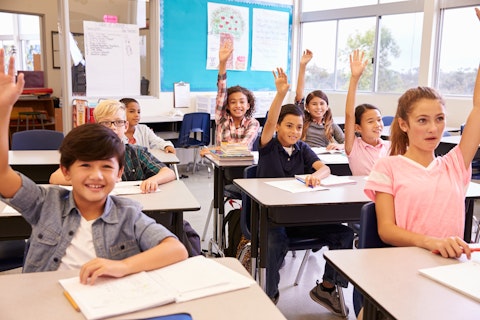In this article, we take a look at 25 countries with education problems. If you would like to skip our detailed analysis of the economic impact of educational limitations, you can directly go to 5 Countries with Education Problems.
The Link Between Education and Employment
Quality education is intricately tied to economic growth, with the two having a profound connection. According to the US Bureau of Labor Statistics, the weekly median pay for someone with a doctoral or professional degree was around $2,080 in 2022. In contrast, for someone with just a high school diploma or a bachelor’s degree, it was $853 and $1,432, respectively. The income data showed a trend of positive growth with the attainment of a higher educational degree, whereas unemployment rates showcased a downward slope. According to data from the World Bank, around the globe, there was a 9% increase in hourly earnings for every extra year of schooling.
Because higher education is generally linked with higher productivity, creativity, and specialized skill sets, those with advanced degrees tend to be higher in demand and get paid better wages. For countries with significant education problems, a large percentage of the population may be kept from accessing the economic opportunities that come with professional degrees. It is because of this gap that the World Bank has invested millions of dollars in education projects in developing countries meant to enhance the overall state of the education sector.
Impact of Education on the Economy
The monetary benefits of better education are not just limited to individual lives; they also influence a country’s economic growth as a whole. According to the OECD, adults with a master’s or doctoral degree earn twice as much as those with just upper secondary education. Because educated citizens earn more, they also pay more in taxes and depend less on social welfare and entitlements, saving government money. This is why even though governments have to bear the cost of higher education, the public economic returns turn out to be positive at every level of education and the highest at tertiary.
Furthermore, the impact of a sound education system is not just on the economic domain; the OECD also noted several social outcomes that were interlinked with the provision of education. The level of social tolerance exhibited by children tends to showcase a positive correlation with the education level of the mother. According to data from OECD, in 17 out of 30 countries, children with tertiary-educated mothers showed the most proclivity for supporting immigrant children’s right to education. Highly educated adults also showed a higher likeliness for participating in acts of civic engagement, such as volunteering for a cause or joining a public demonstration. In the countries that OECD surveyed, 10% of tertiary-educated adults had participated in a public demonstration in the last 12 months, whereas only 6% of those with upper-secondary education had done so.
A study on the link between education and the economy, conducted by the Centre for Economic Performance, found that bridging gaps in educational provision can also lead to improved economic performance. The study found that 24% of the GDP variation across countries could be credited to differences in education attainment. This data corroborates the fact that investing in the quality, as well as higher level, of education can offer prominent benefits to the nation as a whole.
Companies that are Bridging the Educational Gap
While government authorities and transnational organizations both work in collaboration to improve education issues within countries, the private sector has also played a role in this regard. Ed-tech companies such as Coursera, Inc. (NYSE:COUR) and Udemy, Inc. (NASDAQ:UDMY) offer courses in diverse fields, especially beneficial for students who cannot find quality education in their own countries. Not only can individuals access several courses entirely free of cost, but they can also study from renowned institutes worldwide.
On December 9, 2023, Coursera, Inc. (NYSE:COUR) announced that it will partner up with COP28 to release 5,000 free licenses for a unique program offering more than 100 climate-specific courses. Coursera, Inc. (NYSE:COUR) has already received around 3,000 enrollments for the curated program.
Udemy, Inc. (NASDAQ:UDMY) has also been working to improve knowledge provision to its students. On February 1, the company announced the release of a new AI assistant that could facilitate students’ skill development. According to Udemy, Inc. (NASDAQ:UDMY), the assistant will provide personalized recommendations on the most suitable content for the learner. It can also summarize course content to speed up the learning process and offer personalized feedback to aid learners’ comprehension. Udemy, Inc. (NASDAQ:UDMY) also launched AI-driven features for the Udemy Business Leadership Academy, such as a thematic analysis option that could summarize discussions in order to aid the sharing of knowledge.
With this context, let’s now look at the countries with education problems. You can also take a look at the 11 Best Education Stocks To Buy In 2024.

25 Countries with Education Problems
Our Methodology
To curate this list of 25 countries with education problems, we consulted three separate datasets: Adult literacy rates by the World Bank, government education expenditure as a percentage of GDP by the World Bank, and the World Bank‘s dataset on the percentage of female enrollment at a secondary education level. Our hypothesis is that a country with education issues has a low literacy rate, low female enrollment due to gender disparity, and low GDP spending on education.
For the purpose of this ranking, we shortlisted the 60 countries with the lowest ranking on each of these indices. Once we had that list, we calculated the average rank of each country and narrowed down our selection to the 25 countries with the lowest average ranks. The countries with education problems are listed below in descending order of their average ranks. We used literacy rates to break ties between two countries with the same average ranks. Moreover, we used data from UNICEF to provide further context into certain countries.
Please note that data from the World Bank has gaps due to the lack of transparent data from each country. Thus, there might be countries with significant education problems that do not get ranked on this list because of data discrepancies. Furthermore, the World Bank datasets list values from the most recent year of data availability. While some countries had updated values from 2022, others did not. We have mentioned the year along with each statistic as well.
25 Countries with Education Problems
25. Gabon
Education Expenditure as a Percentage of GDP: 2.2% (2022)
Female Enrollment Percentage: 70% (2019)
Literacy Rate: 86% (2022)
Average Ranking: 45.3
According to UNICEF data, most education issues in Gabon start around the secondary level, which is attained by only 50% of the total children. Social factors like drug abuse and crime keep pushing children out of school even as they grow further up and enter adolescence. This is why Gabon is one of the countries with the highest educational problems. Even though the country has a literacy rate of 86%, it is still slightly below the global average of 87%, as reported by the World Economic Forum.
24. Republic of the Congo
Education Expenditure as a Percentage of GDP: 3% (2022)
Female Enrollment Percentage: 46% (2018)
Literacy Rate: 81% (2021)
Average Ranking: 42.3
Global Partnership for Education reports that only 61% of children attend secondary school in the Republic of Congo, many of them kept away by significant ethnic or geographical inequalities. Primary schools also struggle with high repetition rates and a large number of students in every class, which ultimately impacts the quality of education.
23. Democratic Republic of the Congo
Education Expenditure as a Percentage of GDP: 3% (2022)
Female Enrollment Percentage: 44% (2021)
Literacy Rate: 81% (2022)
Average Ranking: 42
Due to ongoing conflicts in the area, UNICEF reports that the education of around 750,000 children has faced disruption. Overall, approximately 7.6 million children aged 5-17 are still out of school, half of which are girls. The secondary enrollment rate for girls is only 44%, whereas for boys, it goes up to 70%.
22. Tanzania
Education Expenditure as a Percentage of GDP: 3.2% (2022)
Female Enrollment Percentage: 29% (2021)
Literacy Rate: 82% (2022)
Average Ranking: 40.3
The net secondary enrollment rate in Tanzania is just 27%, according to UNICEF, which means that 1.7 million children have never attended school in the country. In 2021, the World Bank introduced a new project to improve the quality of primary and pre-primary education for 12 million children. The $500 million BOOST Primary Student Learning Program for Results is aimed at making education more accessible, especially for children who hail from vulnerable and marginalized communities.
21. Cambodia
Education Expenditure as a Percentage of GDP: 1.7% (2021)
Female Enrollment Percentage: 63% (2021)
Literacy Rate: 84% (2022)
Average Ranking: 37.3
Cambodia is one of the countries with education problems, mainly due to a lack of quality teachers and adequate infrastructure within educational institutions. Even though enrollment rates have increased over the years, progress has yet to be witnessed in terms of learning outcomes. According to UNICEF, 25% of primary school kids in Cambodia are unable to write a single word during dictation tests.
20. Madagascar
Education Expenditure as a Percentage of GDP: 3.1% (2022)
Female Enrollment Percentage: 36% (2021)
Literacy Rate: 77% (2022)
Average Ranking: 37.3
Second enrollment for both girls and boys is under 40% in Madagascar, which showcases a significant issue in the country, making it one of the places with the worst education in the world. In 2022, the government spent only 3.1% of its GDP on education, which is lower than the world average. According to IMF data, over the last decade, the completion rates for secondary school have fallen to 35%.
19. Nigeria
Education Expenditure as a Percentage of GDP: 3.1% (1975)
Female Enrollment Percentage: 47% (2021)
Literacy Rate: 62% (2018)
Average Ranking: 37.3
Nigeria is one of the countries with education problems, which is why it’s the site of the $75 million Edo Basic Education Sector and Skills Transformation Operation project by the World Bank, running from 2022 to 2024. The project aims to improve teaching and learning and covers 97% of the schools in the country, with its main focus being on equipping teachers with digital technologies.
18. Cameroon
Education Expenditure as a Percentage of GDP: 2.6% (2022)
Female Enrollment Percentage: 43% (2022)
Literacy Rate: 78% (2020)
Average Ranking: 36
In 2022, Cameroon’s expenditure on education was 2.6% of the total GDP, much below the global average of 4.3%. According to Reliefweb, violent attacks on schools are one of the leading causes behind the impaired education system. 3,285 schools are closed around the country, most of which are concentrated in the Northwest and Southwest regions. Around 1.4 million children are cramped in overcrowded classrooms, awaiting access to quality education.
17. Comoros
Education Expenditure as a Percentage of GDP: 2.4% (2022)
Female Enrollment Percentage: 65% (2018)
Literacy Rate: 62% (2022)
Average Ranking: 33
Comoros is one of the countries with severe education problems. As of 2022, the country has a literacy rate of 62%, whereas education spending is around 2.4% of the total GDP. According to a Global Partnership for Education survey from 2017, 3 out of 4 5th graders did not meet the minimum competence requirements in literacy and mathematics. Comoros has also received education grants from the World Bank to strengthen its overall education system.
16. Benin
Education Expenditure as a Percentage of GDP: 3.2% (2022)
Female Enrollment Percentage: 42% (2022)
Literacy Rate: 47% (2022)
Average Ranking: 31.6
In 2022, Benin had a literacy rate of 47%. The high dropout rate is one of the biggest problems in Benin’s education system. Six out of ten children go to middle school, and only two manage to finish it. The Benin Secondary Education Support Project, supported by the French Development Agency, is the government’s strategy for improving the quality of education.
15. Uganda
Education Expenditure as a Percentage of GDP: 2.6% (2022)
Female Enrollment Percentage: 23% (2017)
Literacy Rate: 81% (2022)
Average Ranking: 29
UNICEF reports that 6 out of 10 children leave school in Uganda due to affordability issues. The enrollment rate amongst the wealthiest segment of the population is 43.1%, whereas for the poorest, it is 8.2%. With only 2.6% of its GDP spent on education, Uganda is one of the countries with significant education problems.
14. Angola
Education Expenditure as a Percentage of GDP: 2.3% (2022)
Female Enrollment Percentage: 42% (2016)
Literacy Rate: 72% (2022)
Average Ranking: 28.6
In 2022, Angola spent 2.3% of its total GDP on the education sector. Looking at the country’s educational issues, the World Bank approved a ten-year tertiary education support program for Angola on December 3, 2023. The three-phase project will allocate a total of $550 million to the country for improving its tertiary education provisions. Around 150,000 students are expected to benefit from the program.
13. Sierra Leone
Education Expenditure as a Percentage of GDP: 3% (2022)
Female Enrollment Percentage: 40% (2017)
Literacy Rate: 49% (2022)
Average Ranking: 27.6
The 2022 literacy rate in Sierra Leone was 49%, showcasing significant gaps in the education system. UNICEF has characterized the country as having a literary crisis, exemplified by the fact that only 6% of third graders were able to read a simple text in 2022. To improve learning outcomes, the World Bank is funding the Sierra Leone Free Education project from 2020-2027.
12. Eritrea
Education Expenditure as a Percentage of GDP: 2.1% (2006)
Female Enrollment Percentage: 40% (2019)
Literacy Rate: 77% (2018)
Average Ranking: 27
Even though Eritrea had a literacy rate of 77% in 2018, many of those children were unable to meet the mastery requirements expected of them. According to UNICEF, in 2018, only 38% of the children in grade 5 showcased the numeracy and literacy proficiency that was expected of them.
11. Sudan
Education Expenditure as a Percentage of GDP: 2% (2009)
Female Enrollment Percentage: 49% (2018)
Literacy Rate: 61% (2018)
Average Ranking: 25
UNICEF reports that 6.9 million Sudanese children are still out of school despite an increase in the number of educational establishments. Prolonged school closures during the COVID-19 pandemic negatively impacted almost 8.1 million children, undoing years of progress in the education sector. This is why Sudan is one of the countries with education problems at an all-time high.
10. Liberia
Education Expenditure as a Percentage of GDP: 2.6% (2022)
Female Enrollment Percentage: 37% (2020)
Literacy Rate: 48% (2017)
Average Ranking: 21
Liberia’s most recent literacy rate data is from 2017, placing the country at 48%. Not only is Liberia one of the countries with education problems, but it is also struggling with a lack of transparent data. In March 2023, the country signed new projects at the UN Doha Conference, under which it aims to enroll 785,060 out-of-school children between 2023 and 2027.
09. Papua New Guinea
Education Expenditure as a Percentage of GDP: 1.9% (2018)
Female Enrollment Percentage: 40% (2018)
Literacy Rate: 62% (2010)
Average Ranking: 18
Based on UNICEF data, around 25% of children aged 6 to 18 are out of school in Papua New Guinea, whereas the transition rate from primary to lower secondary is only 56% for boys and 50% for girls. UNICEF runs several education projects in the country, such as the ‘Education in Emergencies’, which enables disaster-affected children to resume classes as soon as possible.
08. Pakistan
Education Expenditure as a Percentage of GDP: 2% (2022)
Female Enrollment Percentage: 38% (2021)
Literacy Rate: 58% (2019)
Average Ranking: 16.6
In 2019, Pakistan had a literacy rate of 58%, and in 2022, the country spent 2% of its total GDP on the education sector. According to the World Bank, 75% of ten-year-old children in Pakistan are unable to read adequately, a number that may have worsened even further due to the impact of COVID-19 and the 2022 floods. Around 12 million girls are currently out of school, 2 million more than the number of boys, which emphasizes the gender disparity within the country.
07. Mauritania
Education Expenditure as a Percentage of GDP: 1.3% (2022)
Female Enrollment Percentage: 36% (2020)
Literacy Rate: 67% (2021)
Average Ranking: 15.6
In 2022, the government of Mauritania spent only 1.3% of its total GDP on education, which is an alarmingly low amount. This is why Mauritania is one of the countries with the highest education issues. A new education law from 2022 made education compulsory from the ages of five to sixteen, which is a step towards improving the overall education system.
06. Chad
Education Expenditure as a Percentage of GDP: 2.5% (2022)
Female Enrollment Percentage: 18% (2021)
Literacy Rate: 27% (2022)
Average Ranking: 12.6
Chad had a literacy rate of 27% in 2022, which is the lowest in the world. The education level of teachers is one of the biggest educational concerns in Chad. According to UNICEF data, three out of four students are supervised by teachers who have not studied beyond the secondary level. The humanitarian crises in Sudan, CAR, and Nigeria have imposed an enormous burden on Chad’s education system, with around 600,000 refugee children in need of schooling.
Click to continue reading and see the 5 Countries with Education Problems.
Suggested Articles:
- 25 Countries with Best Education System in the World
- 35 Countries With The Best Education in the World
- 20 Countries With The Toughest Education In The World
Disclosure: None. 25 Countries with Education Problems is originally published on Insider Monkey.





